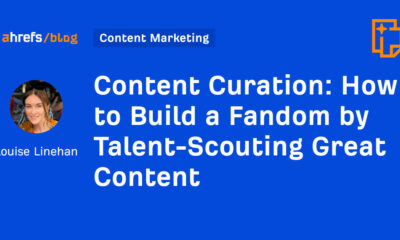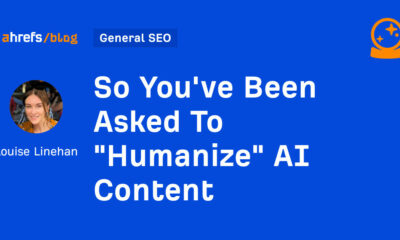MARKETING
Why You Might Not Need a Unified Content Development Process (Yet) [Rose-Colored Glasses]
![Why You Might Not Need a Unified Content Development Process (Yet) [Rose-Colored Glasses] Why You Might Not Need a Unified Content Development Process (Yet) [Rose-Colored Glasses]](https://articles.entireweb.com/wp-content/uploads/2022/01/1641562872_Why-You-Might-Not-Need-a-Unified-Content-Development-Process.png)
The pandemic made organizations care (finally) about building a strategic content development function.
As a result, I see more and more content marketing leaders face the challenge of solving how content flows through the business. It all comes down to organizations finally learning what it means to act like a media company.
It won’t be easy.
Enterprises are a messy thatch of conflicting agendas, values, priorities, and goals. And the effects of these conflicts seem particularly harsh when it comes to content.
Why? Because content is communication. When parts of the business aren’t communicating well internally, the business can’t communicate well externally.
When teams don’t communicate well internally, the business can’t communicate well externally – and that hurts #ContentMarketing, says @Robert_Rose via @CMIContent. Click To Tweet
Who owns which content?
I recently spoke with a marketing leader who plans to launch an initiative to sort out the company’s enterprise content strategy in 2022. The effort arose out of a problem many enterprises face – a lack of agreement about who should drive content development for specific parts of the customer journey.
The marketing team didn’t feel responsible for creating content to cross-sell new products and services to existing customers. But the account services team felt that kind of content should be a core marketing responsibility.
With no one owning the initiative, random acts of customer content occurred.
Existing customers got mixed messages about which new products were available, when, and why they might care. And each team felt frustrated with the results.
Aim to create function from content dysfunction
As the marketing leader dug into the issue, they realized the content development process was dysfunctional from head to toe. But tackling content at an enterprise level felt overwhelming.
Leaders in some of the other affected areas couldn’t agree on which part of the process caused the most problems. The refrain “it’s not my team” echoed through the figurative hallways.
I advised the marketing leader to look for ways to create function within the dysfunction.
Don’t try to dictate a content approach for the entire journey, I suggested. Instead, remove the dysfunction from the content process for one part of the customer journey at a time.
Don’t try to dictate a #content workflow for the entire customer journey. Try removing dysfunction from one journey stage at a time, says @Robert_Rose via @CMIContent. Click To Tweet
Marketing teams often look at content from a lifecycle perspective. They ideate, create, produce, activate, manage, and measure it. The natural tendency is to create a process that solves one part of that lifecycle.
Usually, discreet teams handle each step of that lifecycle. Creators handle content creation. Design teams package and manage the content. Channel managers activate and promote the content. It seems easier to solve by team than by the customer journey.
Spoiler alert: It’s not. The creation process for awareness content could (and probably should) look very different from the creation process for customer service content.
It may be more productive to look at the content development process in a siloed way. For example, ask, “What does the ideate, create, produce, manage, activate, and promotion look like for X?” (where X represents a specific part of the customer journey, a content platform, or a particular channel).
Yes, this approach maintains the silos. But it’s an opening gambit for building a functional process within a dysfunctional organization.
Once you’ve developed a process that works for X, you can move to the next part of the customer’s journey and solve the dysfunction there.
HANDPICKED RELATED CONTENT:
More process, but less complexity
The key to this approach is to avoid getting caught up in how things should work vs. how they do work.
The way one team handles content development might work well for them – and not well at all for a different team.
The way one team handles #content development might work well for them – and not well at all for a different team, says @Robert_Rose via @CMIContent. Click To Tweet
For example, in the company I mentioned previously, a marketing person collects ideas for website content in a spreadsheet that lists priorities for which pieces to create and which to translate for global audiences. The spreadsheet lives on a server for anyone to find. The approach works fine for the global marketing team and the translation agency. But someone on another team wouldn’t know where to look for that spreadsheet and wouldn’t understand how or when that prioritization occurs.
Could that process be better? Maybe. Maybe not.
A pragmatic approach to content development isn’t all or nothing. The point isn’t to remove all variation – or even every dysfunction.
The goal should be to remove enough dysfunction to communicate effectively.
Remember, the more information you create to communicate with other teams, the less you create to deliver value to your audience and customer.
It’s your story. Tell it well.
Rose-Colored Glasses is a new weekly column in which Robert Rose shares his view of content marketing challenges. Every Friday, he offers reasoning, rationale, and rhetoric to help you advance the practice of content marketing in your organization.
Subscribe to workday or weekly CMI emails to get Rose-Colored Glasses in your inbox each week.
Cover image by Joseph Kalinowski/Content Marketing Institute



















You must be logged in to post a comment Login